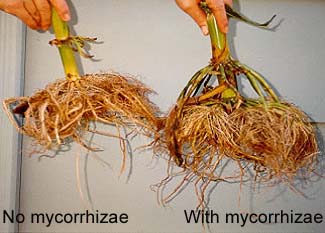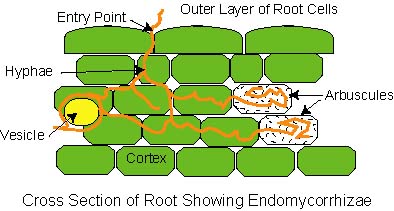|
|
|
Fact Sheet 01-29 |
|
MYCORRHIZAE Angela M. O’Callaghan,
Ph.D.
|
|
When plants live in challenging locations, they often develop mechanisms to help them survive. These include morphological characteristics such as thickened, small or narrow leaves to reduce water loss, slowing the plant's growth rate, or developing a tolerance for high salts and low levels of nutrients. One important set of survival mechanisms involves creating mutually beneficial (symbiotic) relationships between plant roots and soil-borne organisms such as bacteria and fungi. |
|
What are mycorrhizae? |
|
The associations between roots and fungi are called mycorrhizae. These symbiotic arrangements have been found in about 90% of all land plants, and have been around for approximately 400 million years. Plant roots are hospitable sites for the fungi to anchor and produce their threads (hyphae). The roots provide essential nutrients for the growth of the fungi. In return, the large mass of fungal hyphae acts as a virtual root system for the plants, increasing the amount of water and nutrients that the plant may obtain from the surrounding soil. A plant that forms an association benefiting both the fungus and the plant is a "host." Large numbers of native desert plants are hosts to these fungi and would not survive without them. Two general terms are used to describe virtually all mycorrhizae: |
|
|
What do mycorrhizae do? |
| Nutrients and water
Mycorrhizae are essential in areas where
soils are deficient in water and certain nutrients - conditions that are
found in the desert. Even when there is an ample amount of a nutrient, it
may not be readily accessible to the plant. A dramatically larger root
system (or When mycorrhizae are present, plants are less
susceptible to water stress. Not only do the fungal threads help to bring
water and nutrition into the plant, but they also can store them for use
when rainfall is sparse and temperatures are high. When organic matter
(compost) is added to improve a soil, mycorrhizae are important in making
its nutrients available. The residual organic matter and the hyphae
improve the structure of the soil. Recent research indicates that the
fungi even help break down rock, increasing availability of the essential
nutrients within, such as potassium, calcium, zinc and
magnesium. |
|
|
|
Disease resistance Mycorrhizae also help the plant resist infection by other fungi and even bacteria. This may be because the plant, being better nourished, is healthier and has better resistance to the invader. It may also be that the large physical presence of one fungus impedes infection by others. Another possibility is that either the plant or the fungus produces compounds that prevent infection by pathogens. Interaction with other soil microbes — a cycle of benefit Desert plants interact with other organisms
in the soil. Many of these microorganisms fertilize plants by "fixing"
nitrogen, which is then available for plant growth. When mycorrhizae are
present, the number and vitality of these nitrogen fixers increase. As a
result, the plant‘s health and vigor improves, as does the health and
vigor of the beneficial fungi. |
|
Will any fungus form
mycorrhizae? |
|
Many fungi will form associations with plants, and many plants will form mycorrhizal associations. These interactions appear to be plant- and fungus-specific. Not all mycorrhizae-forming fungi will work with all desert plants. There are research reports which show that association with the "wrong" fungus actually decreases the health and vigor of the plant. Because there is a requirement for specific plant-fungus association, mycorrhizae can be important in reestablishing native species in areas where they have been lost. Mycorrhizal fungi are available for sale from several sources. Introducing mycorrhizal fungal spores
(inoculation) is sometimes suggested to improve yields and plant vigor,
particularly for container and landscape ornamentals. Inoculation with
mycorrhizal fungi may not be a benefit unless it is specific to the plant,
because there is a requirement for a specific fungus-plant interaction for
optimum benefit. It would also be counterproductive to inoculate with a
fungus that could strongly benefit a weedy species. |
|
How do mycorrhizae get into a
site? |
|
Many desert soils already have mycorrhizal
fungi present, at least in small amounts. Even without inoculation, spores
can be found in many desert locations. If host plants are grown where
there are spores of these fungi, then both thrive. The mycorrhizal fungi
may continue to survive even after the original host is no longer
present. |
|
|
|
The hyphae enter the root and create swellings (vesicles) for nutrient storage structures where nutrients are transferred between fungus and plant (arbuscules). The names of these two structures are combined into "vesicular-arbuscular mycorrhizae" (VAM), the term for the most common type of mycorrhizal association. |
|
Maintaining mycorrhizae in the
soil |
|
There is no sure-fire way to guarantee natural mycorrhizal populations, but in order to increase the amount of fungi, follow a couple of basic rules. When planting a desert native, make sure that the root ball contains native soil. This is where the mycorrhizal fungi reside; without the fungi, there can be no associations. Just as important, be very careful when using pesticides, particularly fungicides. Do not apply them to the soil. Fungicides kill all the fungi they encounter. While they can be effective against plant disease, they can destroy beneficial fungi and cause serious problems to plant survival. References: Allen, M. F. 1991. Ecology of Mycorrhizae (Cambridge Studies in Ecology). Cambridge University Press. Cambridge, UK. Jordan, N.R., J. Zhang, and S. Huerd. 2000. Arbuscular-mycorrhizal
fungi: potential roles Mathur, N. and A. Vyas. 2000. Influence of arbuscular mycorrhizae on biomass production, nutrient uptake and physiological changes in Ziziphus mauritiana Lam. under water stress. 2000. Journal of Arid Environments, 45: 191-195. Parniske, M. 2000. Intracellular accommodation of microbes by plants: a
common developmental program for symbiosis and disease? Current opinion in
plant biology. Rabie, G. H. 1998. Induction of fungal disease resistance in Vicia faba
by dual inoculation with Rhizobium leguminosarum and vesicular-arbuscular
mycorrhizal fungi. http://invam.caf.wvu.edu/ http://www.ars.usda.gov/is/AR/archive/may01/fungi0501.htm |
| Adapted from a page on Mycorrhizae |


